The Most Innovative Products for External Walls & Facades in 2024
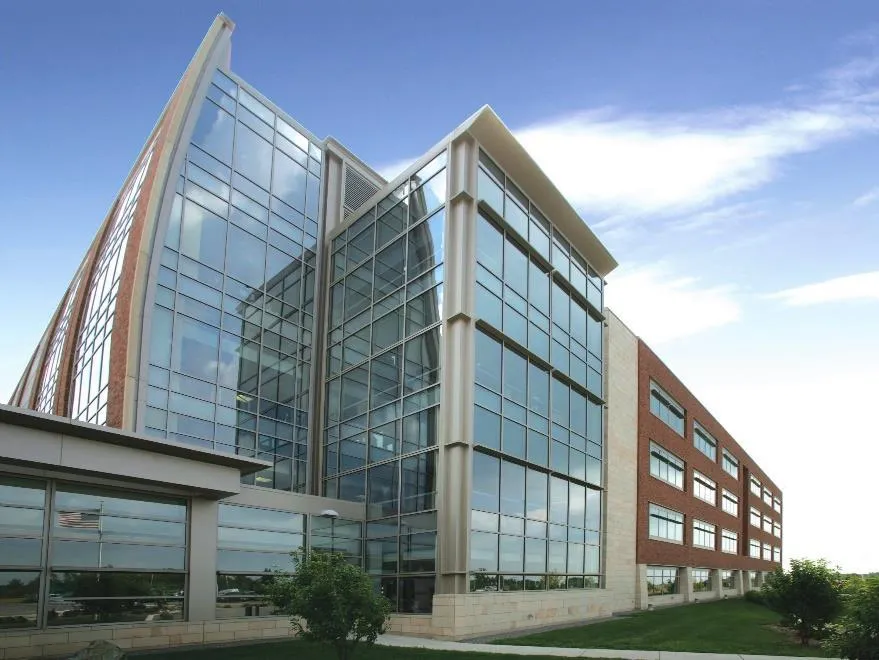
The construction industry is undergoing a remarkable transformation as sustainability becomes a top priority. With increasing environmental concerns and stricter regulations, the demand for green buildings has surged. One of the most crucial aspects of sustainable building design is the selection of external wall systems and facades, as these not only shape a building’s aesthetic but also play a critical role in energy efficiency, insulation, and overall environmental impact.
In this article, we explore some of the most innovative external walls and facades. These products are designed to reduce carbon emissions, improve energy performance, and minimize the depletion of natural resources, all while maintaining high standards of durability and design. From photovoltaic facades to low-carbon wall systems, these solutions offer environmentally conscious alternatives that meet the needs of modern construction projects. Whether you’re working on a new build or a retrofit, incorporating these products can make a significant difference in creating greener, more efficient structures.
Here are 12 standout products that are leading the way in the construction industry.
1. Building Integrated Photovoltaic (BIPV) Facade Cladding by SolarLab
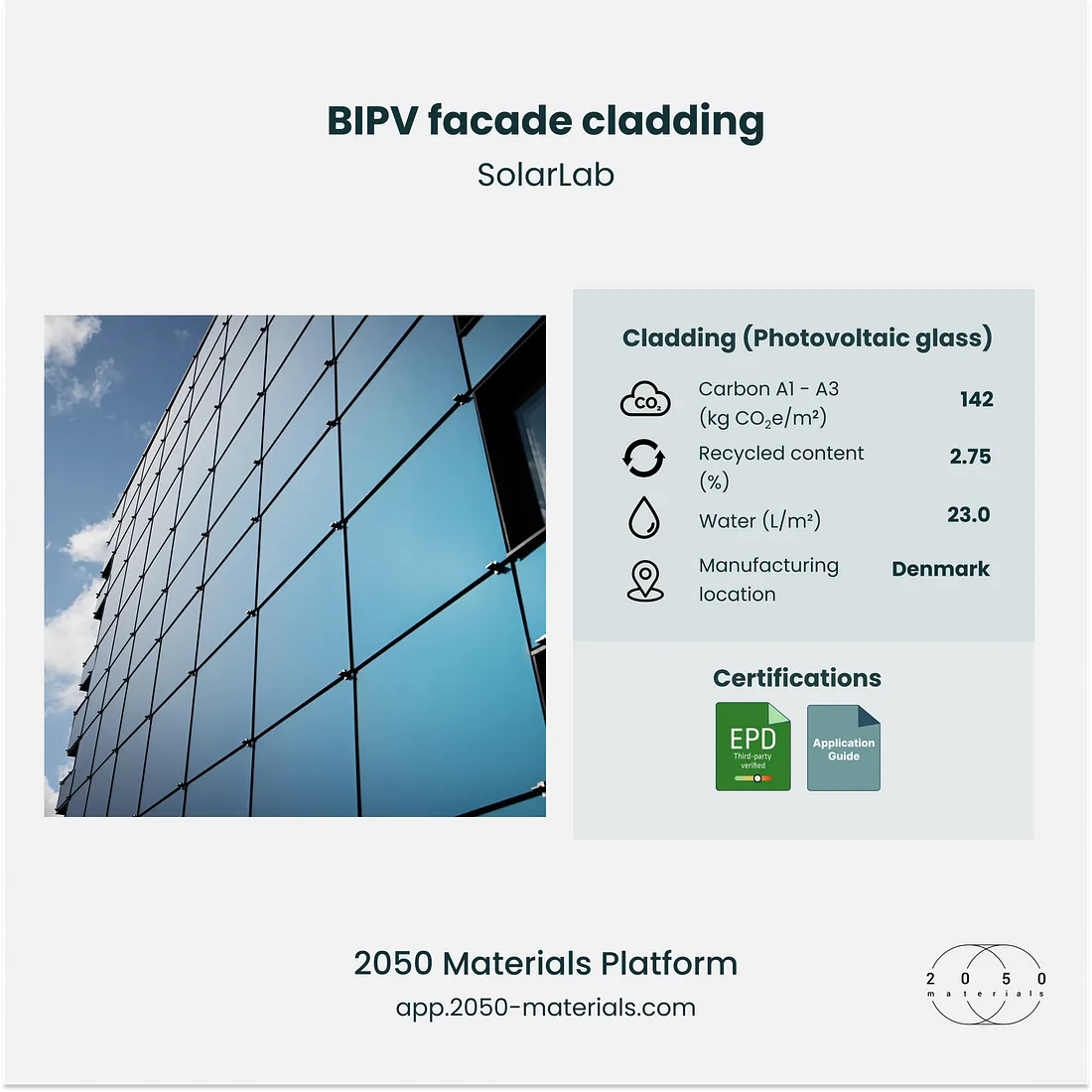
Product Overview
The Building Integrated Photovoltaic (BIPV) Facade Cladding by SolarLab combines functionality and sustainability in one innovative package. Manufactured in Denmark, this photovoltaic glass cladding serves a dual purpose, acting both as an energy-producing panel and a rain screen that shields buildings from external elements. It is designed to blend seamlessly into a building’s architecture while reducing reliance on traditional, non-renewable energy sources.
Sustainability Performance
The SolarLab BIPV facade cladding holds an Environmental Product Declaration (EPD) certification, demonstrating its compliance with rigorous environmental standards. One of its key sustainability features is its European supply chain, which ensures lower transportation emissions and a reduced carbon footprint compared to products manufactured outside of Europe. By integrating photovoltaic technology directly into the building envelope, it actively contributes to lowering the building’s overall energy consumption by generating electricity on-site.
Advantages
- Renewable Energy Production: The BIPV systems are seamlessly integrated into a building’s facade, offering an unobtrusive method for harnessing solar energy. By converting building exteriors into solar energy generators, these facades provide a fast payback period, effectively making them the only building material that pays for itself.
- Low Carbon Footprint: With a focus on reducing emissions during production and transportation, the BIPV cladding offers significant carbon savings compared to traditional cladding materials.
- Shade for Enhanced Efficiency: Beyond energy production, SolarLab’s facades provide additional shading to the building, reducing direct sunlight exposure and lowering cooling requirements. This dual-functionality optimizes the building’s energy usage, leading to significant reductions in electricity demand for air conditioning systems.
Use Cases
- Ideal for urban buildings focused on energy efficiency.
- Suitable for residential, commercial, and institutional projects aiming for energy self-sufficiency.
2. Ecococon Wall Panels by EcoCocon UAB
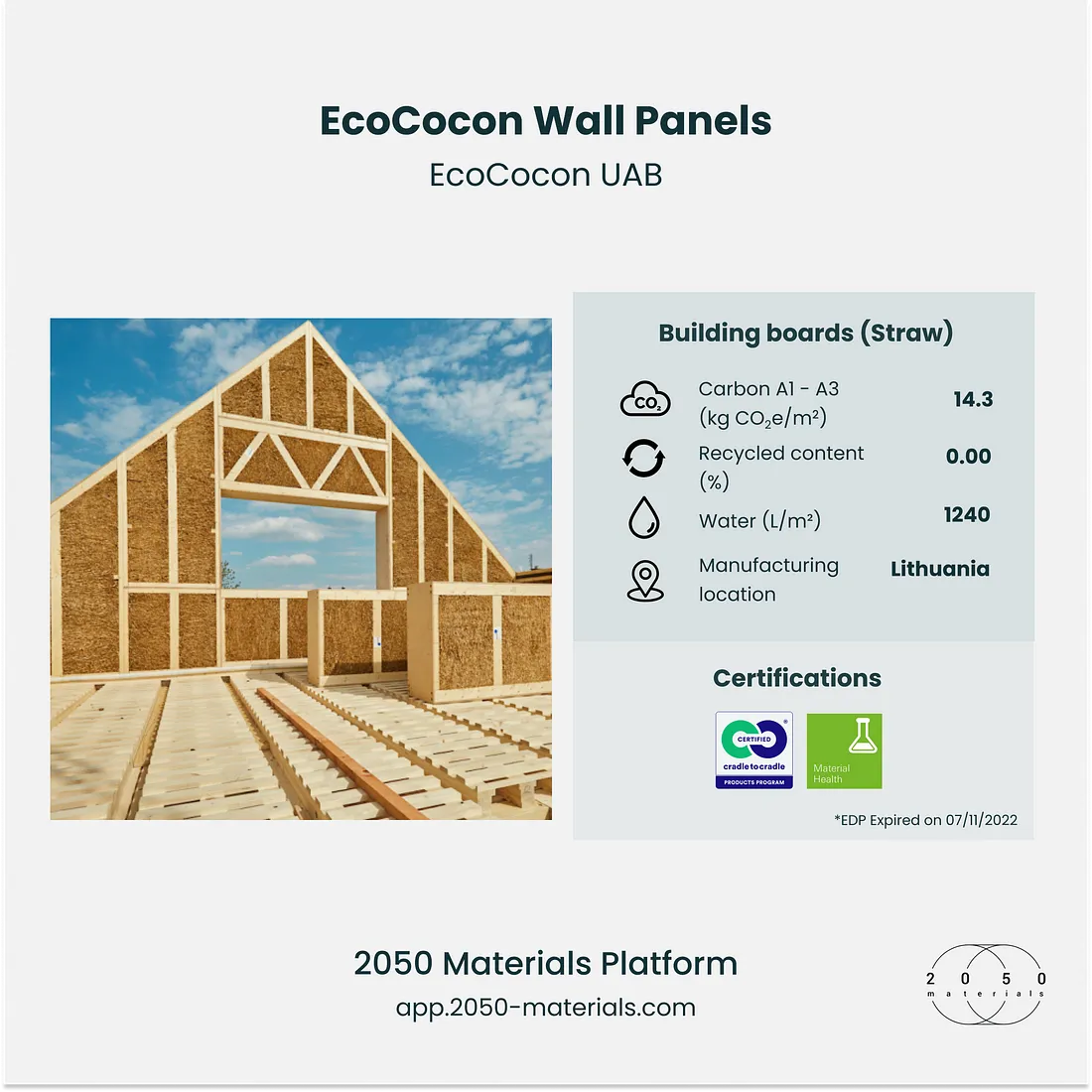
Product Overview
EcoCocon panels by EcoCocon UAB are made from 98% natural, renewable materials, offering an alternative to conventional wall systems with sustainable properties. With a focus on creating a natural and healthy indoor environment, these panels emit no harmful substances, ensuring excellent indoor air quality. The breathable structure of the system allows excess humidity to escape, promoting a balanced and comfortable indoor climate year-round.
Sustainability Performance
The EcoCocon system has sustainable properties, it utilizes nearly all-natural, renewable resources. By reducing synthetic and processed materials, it contributes to a lower carbon footprint. The breathable design helps maintain indoor air quality and prevents issues such as mold growth, promoting long-term health benefits. Additionally, the airtight and thermal-bridge-free construction enhances energy efficiency, reducing the need for heating and cooling.
Advantages
- High Indoor Air Quality: Made from natural materials, the panels do not emit harmful chemicals, ensuring clean, healthy indoor air.
- Breathable Design: Allows excess humidity to escape, reducing the risk of mold and mildew.
- Thermal Comfort: Provides stable indoor temperatures, remaining warm in winter and cool in summer.
- Energy Efficiency: Airtight design without thermal bridges, minimizing energy loss and preventing drafts.
Use Cases
- Ideal for residential buildings that prioritize occupant health and indoor air quality.
- Suitable for passive and low-energy buildings where energy efficiency and natural insulation are essential.
- Excellent for schools, offices, and healthcare facilities, where indoor air quality and a comfortable microclimate enhance wellbeing and productivity.
Explore EcoCocon Straw Wall Panels on 2050 Materials Platform here.
3. ModCell Straw Technology by ModCell
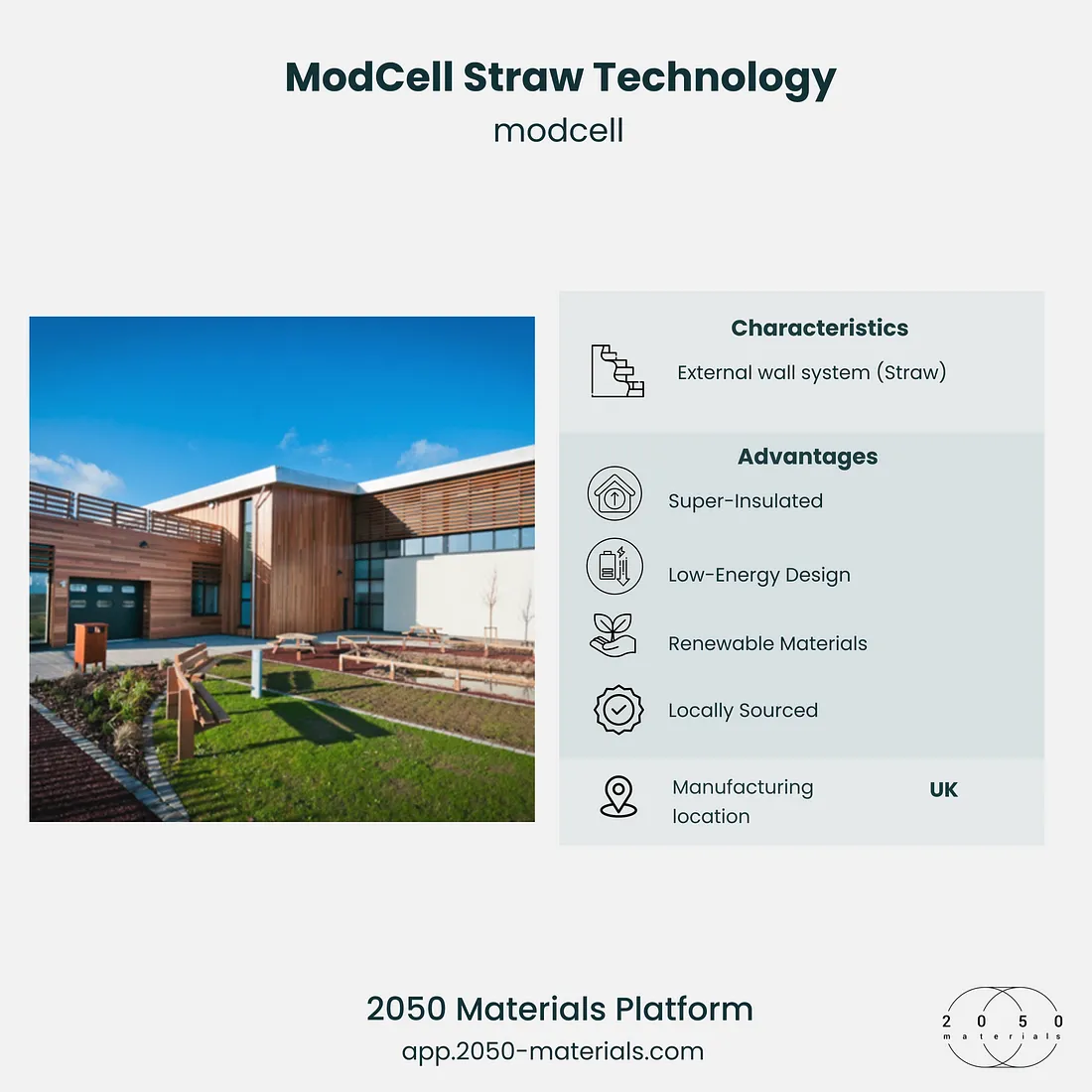
Product Overview
ModCell’s technology combines straw and wood to create a carbon-sequestering external wall system. Made in the UK, ModCell uses locally sourced materials, supporting a sustainable supply chain.
Sustainability Performance
This ISO 9001-certified product sequesters carbon and emphasizes renewable, low-impact materials. Its design supports green building standards.
Advantages
- Carbon Sequestration: Reduces the building’s overall carbon footprint.
- Local Sourcing: Supports local economies and reduces transportation emissions.
- High Insulation: Provides excellent thermal performance, ideal for passive building designs.
Use Cases
- Suitable for passive buildings, educational institutions, and residential projects focused on sustainability.
- Supports green certification programs and sustainable construction standards.
Explore ModCell Straw Technology on 2050 Materials Platform here.
4. MU800 Hi Triple-Glazed Facade Unit by Architectural & Metal Systems Ltd.
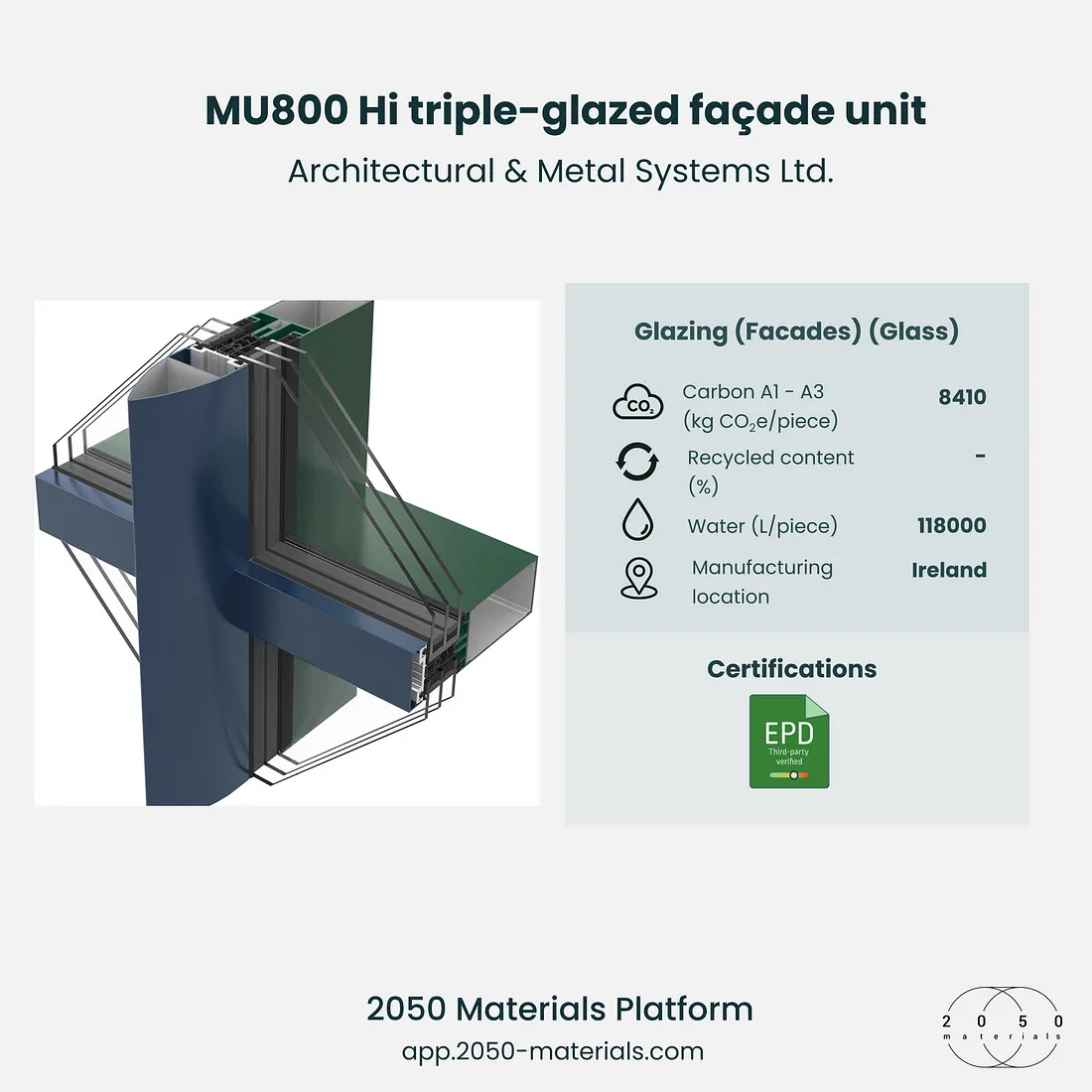
Product Overview
The MU800 by Architectural & Metal Systems Ltd. is a triple-glazed facade unit that offers top-tier thermal insulation. Assembled in Ireland, it incorporates energy-efficient design elements, including aluminum profiles with thermal breaks.
Sustainability Performance
EPD-certified, the MU800 unit minimizes heat transfer, enhancing building efficiency. Its recyclable aluminum profile contributes to sustainable lifecycle management.
Advantages
- Enhanced Insulation: Triple glazing offers superior thermal performance.
- Durable and Recyclable: Made from aluminum profiles that are both strong and recyclable.
- Reduced Energy Use: Helps reduce heating and cooling needs in extreme climates.
Use Cases
- Suitable for residential, commercial, and educational buildings in areas with temperature extremes.
- Perfect for projects focused on reducing energy costs and carbon emissions.
Explore MU800 Hi Triple-Glazed Facade Unit on 2050 Materials Platform here.
5. Double Vitrage CLIMAPLUS© ORAE© by Saint-Gobain GLASS
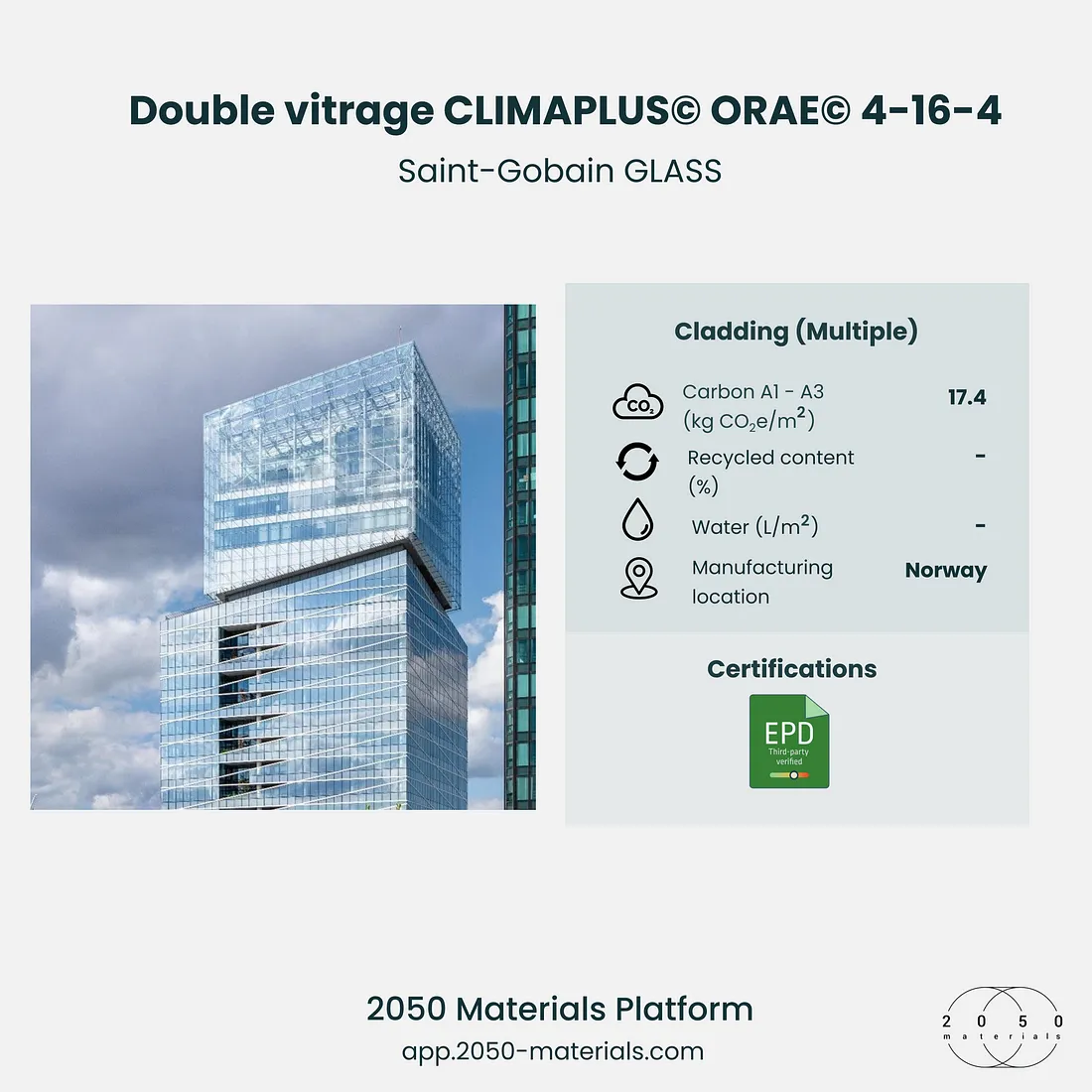
Product Overview
This double-glazing system by Saint-Gobain GLASS uses 64% recycled glass, making it a low-carbon alternative to conventional glazing. It’s produced by Saint-Gobain and has exceptional thermal insulation properties.
Sustainability Performance
With a carbon footprint of only 18.4 kg CO₂ per m², it outperforms standard options by 8.5 kg CO₂ per m². The EPD certification highlights its commitment to sustainability.
Advantages
- Low Carbon Footprint: Carbon emissions are 8.5 kg CO₂/m² lower than traditional glazing.
- Recycled Content: Made with over 50% recycled glass, supporting circular economy principles.
- High Thermal Efficiency: Provides effective insulation for energy savings.
Use Cases
- Ideal for residential, commercial, and institutional buildings.
- Suitable for projects aiming to reduce operational energy costs.
Explore Double Vitrage CLIMAPLUS ORAE on 2050 Materials Platform here.
6. StoVentec Glass A by Sto SE & Co. KGaA
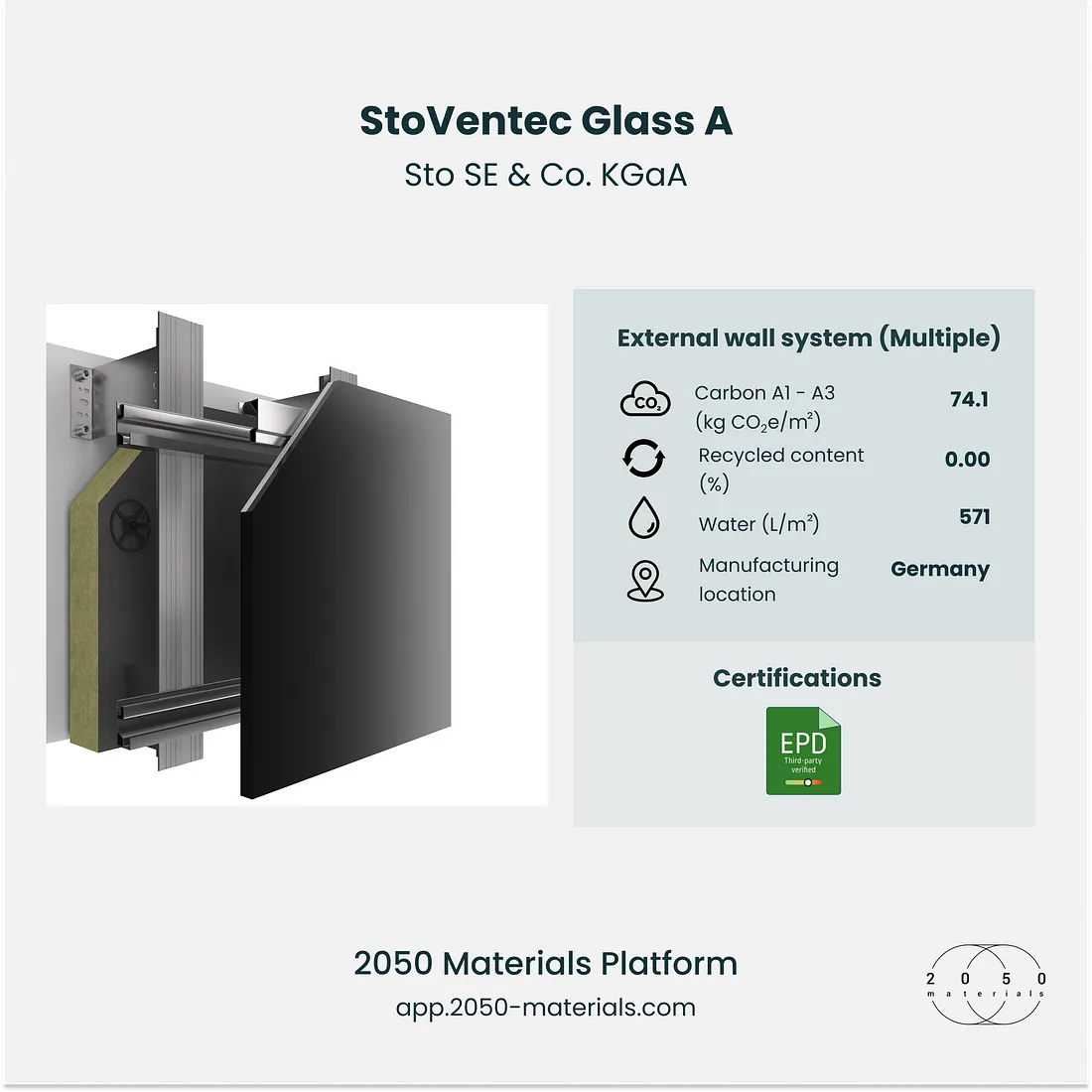
Product Overview
StoVentec Glass A by Sto SE & Co. KGaA is a rainscreen cladding system designed for high-performance external walls. Manufactured by Sto SE & Co. KGaA, this product is used as a joint-accentuated facade panel, offering both functional and aesthetic advantages. StoVentec Glass A is known for its durability, weather resistance, and ability to contribute to energy-efficient building designs.
Sustainability Performance
Certified with an Environmental Product Declaration (EPD), StoVentec Glass A is made with sustainability in mind. Its production process prioritizes the efficient use of materials, and its long-lasting performance ensures that buildings remain well-insulated and protected from environmental elements. The use of this product in rainscreen systems helps reduce heating and cooling loads, contributing to overall energy savings.
Advantages
- Aesthetic Versatility: StoVentec Glass A offers a wide range of design options, allowing architects to achieve unique visual effects while maintaining sustainability.
- Durable and Weather-Resistant: The cladding system is built to withstand extreme weather conditions, ensuring long-term performance.
- Energy Efficiency: By enhancing the building envelope’s insulation properties, StoVentec Glass A helps reduce energy consumption.
Use Cases
- Suitable for commercial and high-rise buildings where aesthetics and energy efficiency are key.
- Commonly used in rainscreen systems that balance design with sustainability.
7. Wall Panels: Load-bearing by Nexii
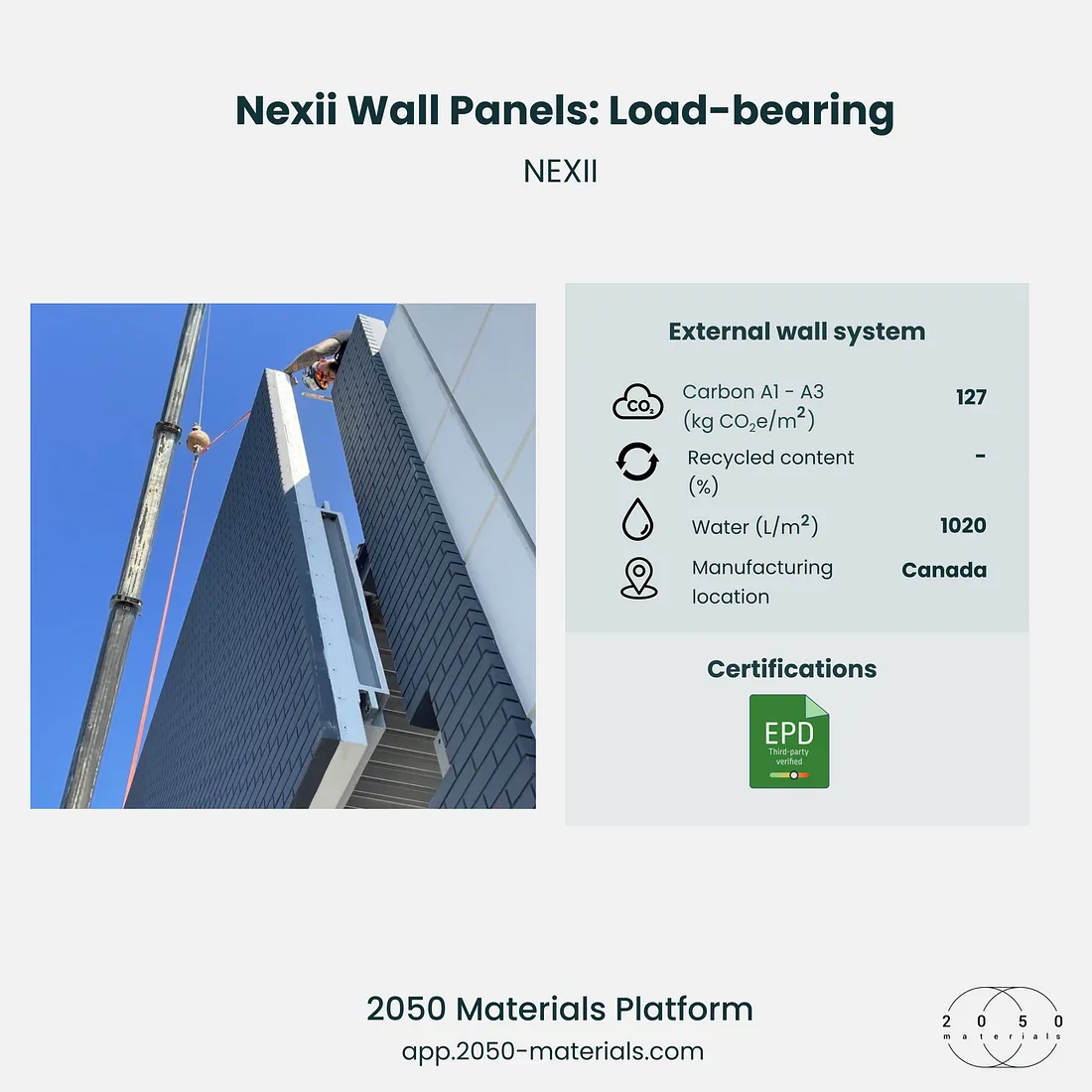
Product Overview
Nexii wall panels by NEXII provide structural support and serve as part of a precision-manufactured building envelope. Primarily used in commercial projects, these panels are designed for efficient transportation and quick on-site assembly.
Sustainability Performance
The Nexii panels boast EPD certification and focus on a minimized carbon footprint through optimized transportation and rapid assembly, reducing energy consumption during construction.
Advantages
- Quick Assembly: Precision manufacturing speeds up construction time.
- Structural Support: Designed to support one-story buildings, including roof structures.
- Energy Efficient: Optimized for reduced energy consumption during construction.
Use Cases
- Well-suited for commercial retail projects requiring structural support and quick installation.
- Ideal for one-story structures where time and efficiency are critical.
8. Processed Glass by Cardinal Glass Industries
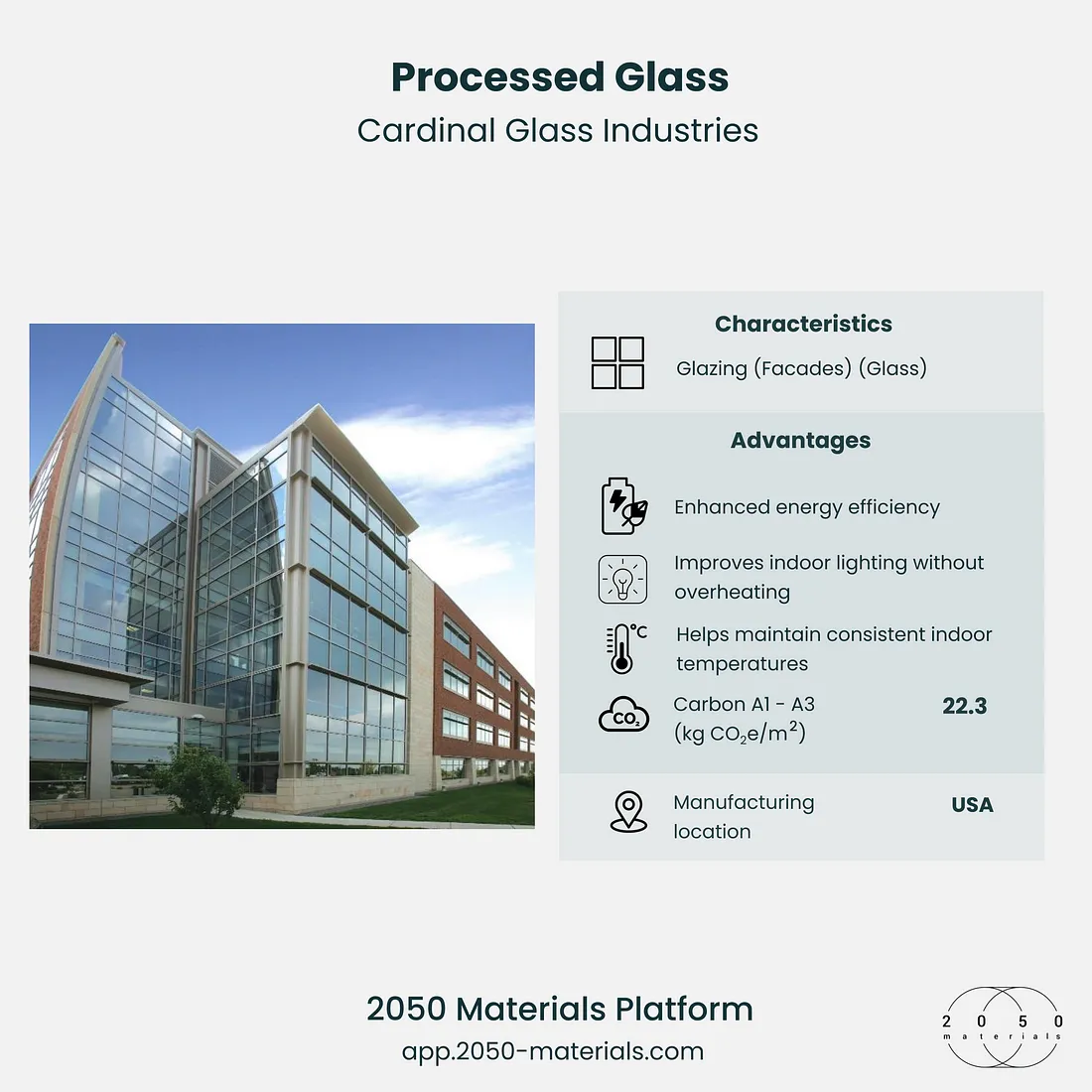
Product Overview
Cardinal’s Processed Glass is a triple-pane insulating glass unit designed for superior thermal comfort in cold weather. It offers versatile spacer thicknesses to fit various insulation needs.
Sustainability Performance
While lacking specific certifications, the Endur IG spacer prioritizes energy efficiency and thermal comfort, reducing heating needs in cold climates.
Advantages
- Thermal Comfort: Triple-pane design reduces heat loss in winter.
- Versatility: Customizable thickness for various insulation needs.
- Energy Savings: Reduces reliance on heating in colder regions.
Use Cases
- Ideal for residential and commercial buildings in cold climates.
- Provides increased comfort and energy savings in extreme winter conditions.
Explore Cardinal’s Processed Glass on 2050 Materials Platform here.
9. Woodify Optimum — Thermowood by Woodify
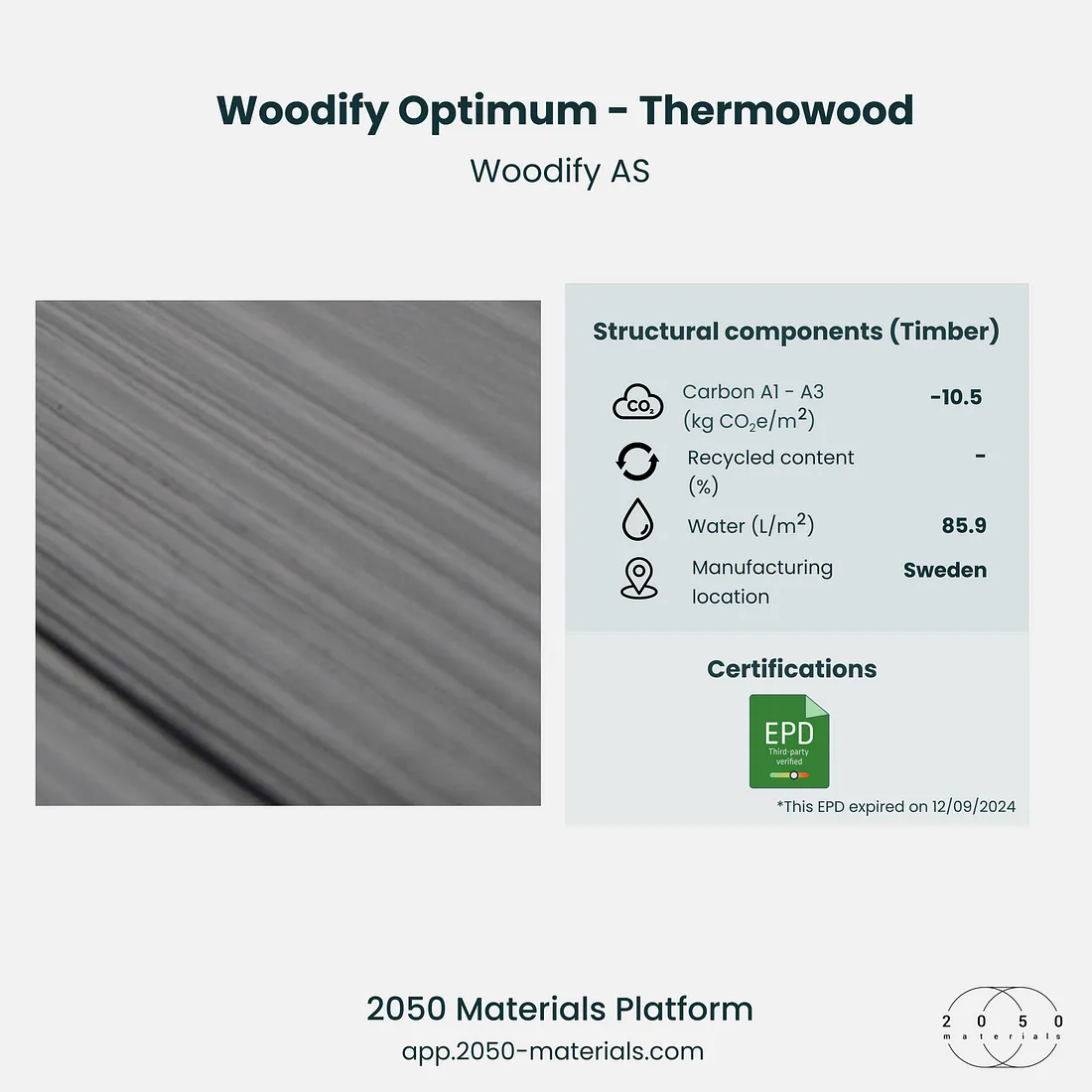
Product Overview
Woodify’s Thermowood is a natural cladding material treated with heat and steam for durability. Sourced from sustainable forestry, it includes species like pine, spruce, and ash.
Sustainability Performance
The Thermo-D heat treatment process enhances wood’s biological durability without chemicals, making it a sustainable, rot-resistant cladding option.
Advantages
- Chemical-Free Durability: Heat treatment enhances wood’s natural resilience.
- Rot Resistance: Reduces the frequency of replacements.
- Low Maintenance: Maintains stability in various climates.
Use Cases
- Suitable for residential and commercial facades in wet or harsh climates.
- Ideal for projects prioritizing natural aesthetics and durability.
10. Natural Stone by Kivi ry
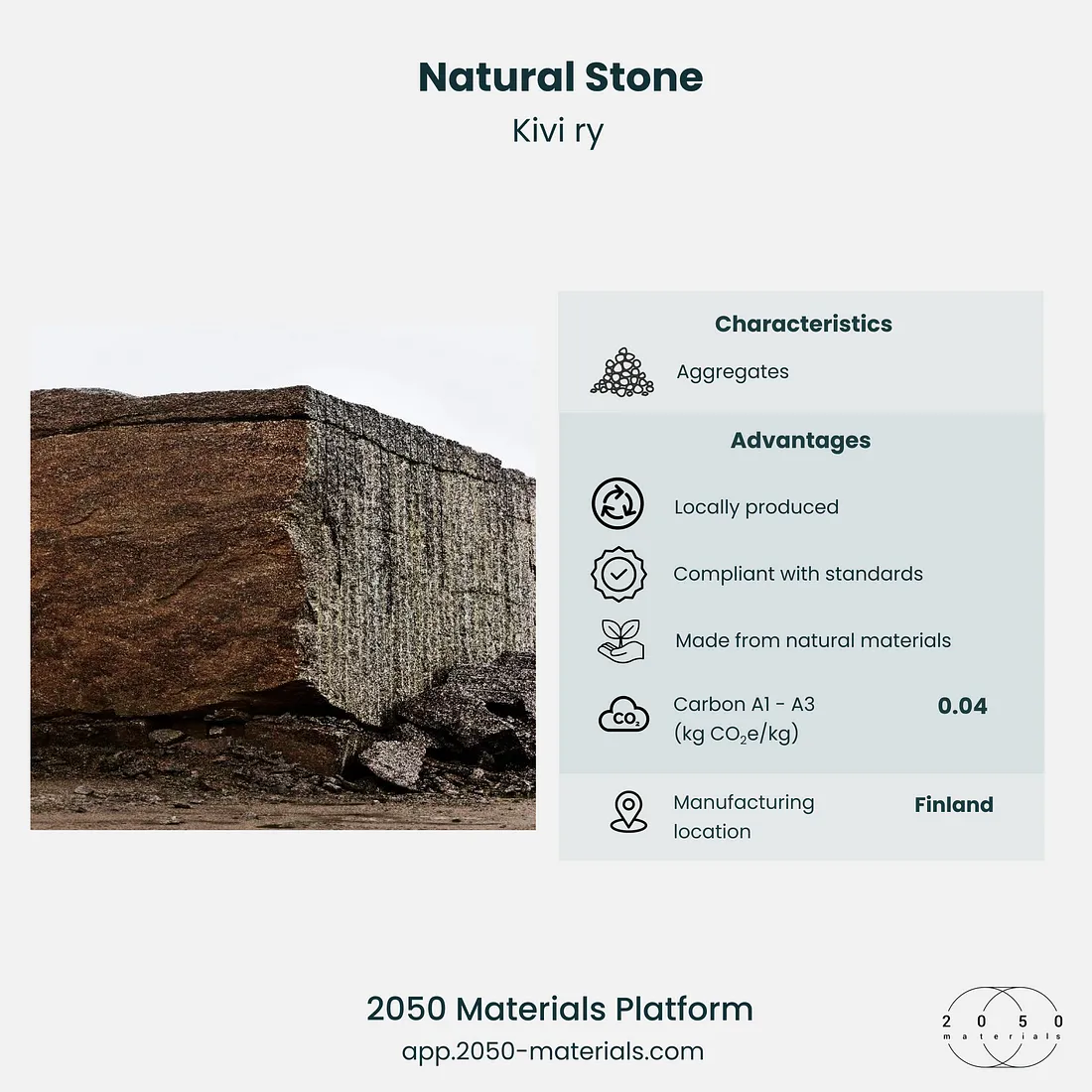
Product Overview
Kivi’s natural stone facade materials are known for a low carbon footprint, thanks to local sourcing in Finland. This product brings both durability and aesthetic appeal to external walls.
Sustainability Performance
A lifecycle assessment by Bionova Ltd. confirms that Finnish natural stone has a lower carbon footprint than many other facade materials. EPD certification further supports its environmental credentials.
Advantages
- Timeless Aesthetics: Adds a natural look to facades.
- Low Carbon Footprint: Locally sourced, reducing transportation emissions.
- Durable: Resilient material that requires minimal maintenance.
Use Cases
- Ideal for low-maintenance, high-aesthetic residential and commercial projects.
- Suitable for facade applications focusing on durability and a timeless look.
11. Greencoat PLX Pural BT by SSAB Swedish Steel Ltd
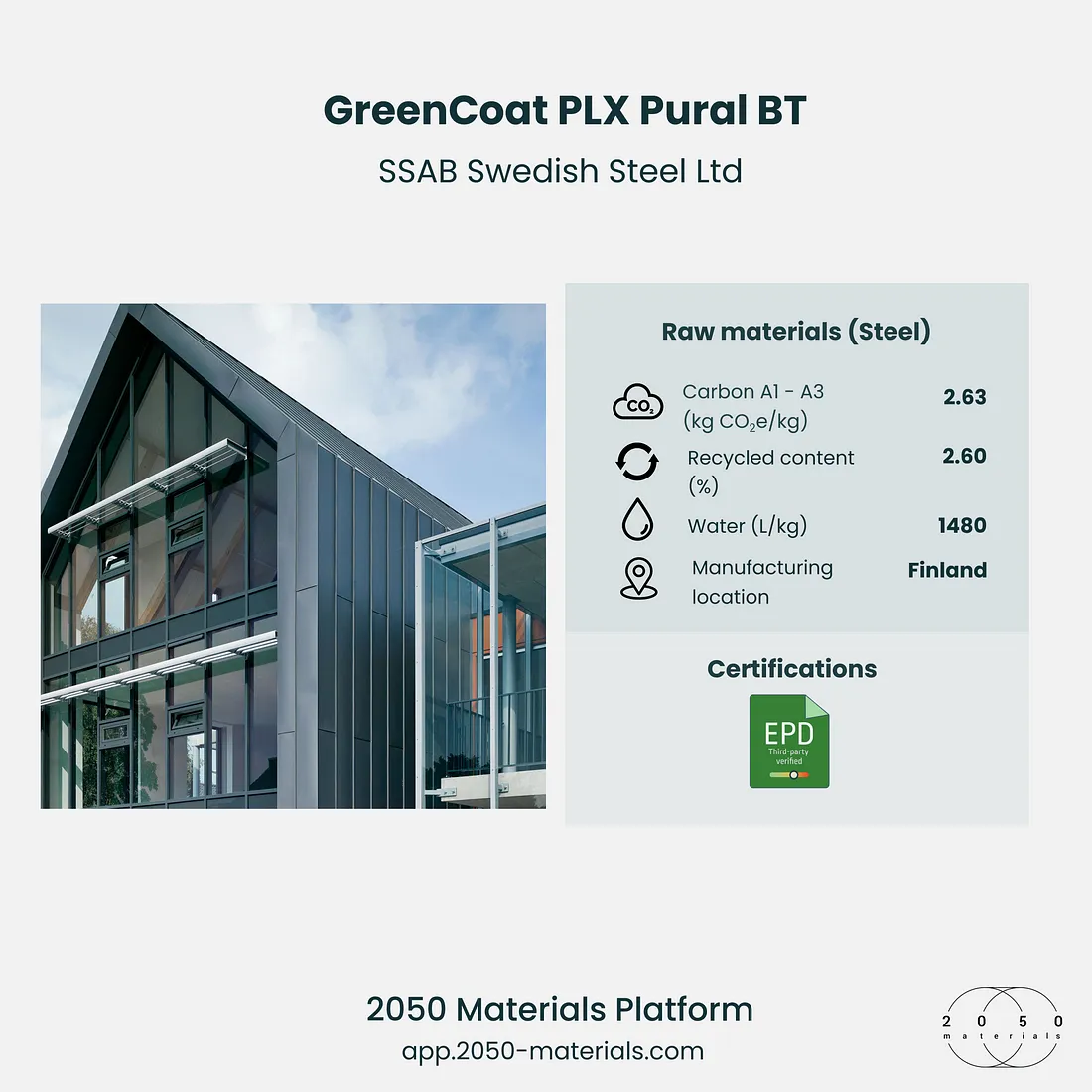
Product Overview
GreenCoat steel plates by SSAB Swedish Steel Ltd are highly resistant to corrosion and UV radiation. These lightweight, durable steel plates are used in both the building industry and light engineering.
Sustainability Performance
EPD-certified, the GreenCoat steel plate reduces environmental impact by minimizing maintenance requirements. It is also designed for durability, withstanding temperatures as low as -15°C.
Advantages
- UV and Corrosion Resistance: Protects against environmental damage.
- Lightweight and Easy to Work With: Simplifies installation even in colder climates.
- Long-Lasting: Durable material that reduces long-term maintenance.
Use Cases
- Suitable for facades and roofs in extreme climates.
- Great for both residential and commercial projects needing durable and resilient cladding.
Explore Coloured Steel Plate on 2050 Materials Platform here.
12. Cembrit Solid by Cembrit
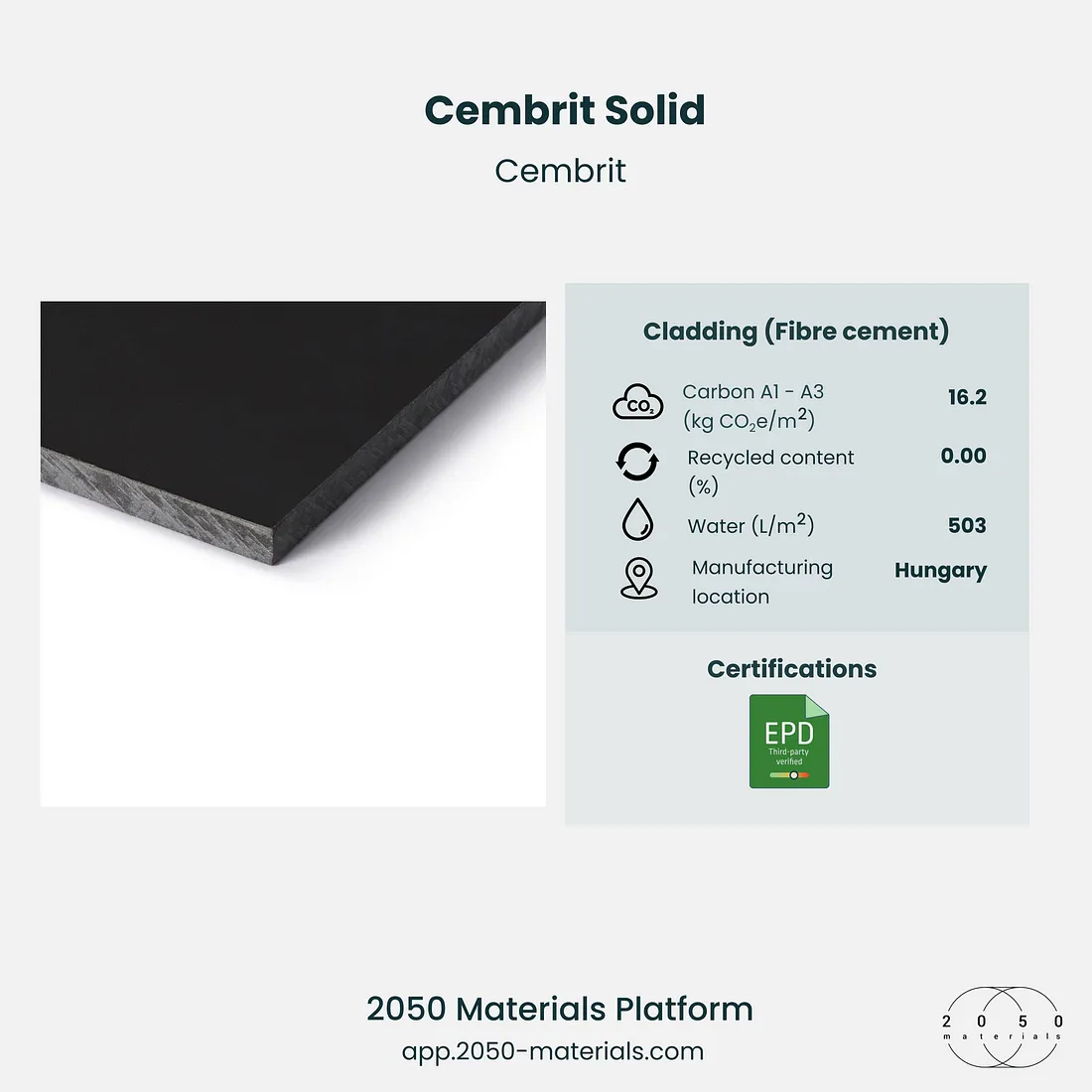
Product Overview
Cembrit Solid offers fiber cement rain screen cladding, suitable for facades or roofs. Its back-ventilated design enhances moisture management and extends the facade’s longevity.
Sustainability Performance
This EPD-certified cladding reduces the need for additional insulation, enhancing energy efficiency. Its fiber cement composition contributes to durability and longevity in various climates.
Advantages
- Moisture-Resistant Design: Ideal for high-humidity environments.
- Energy Efficient: Reduces heating and cooling needs through better insulation.
- Durable Material: Long-lasting and suitable for varied climates.
Use Cases
- Suitable for both residential and commercial facades.
- Works well in wet or humid regions that require moisture-resistant materials.
Conclusion
These materials with innovative properties exemplify how the construction industry is adapting to reduce its carbon footprint. From carbon-sequestering straw walls to energy-efficient glazing, these products represent the future of sustainable building design.
Sign up to the 2050 Materials Platform and discover more innovative products.
Related articles

Climate-Resilient Materials for the Built Environment: A Data-Centred Prime
As climate volatility intensifies, resilience metrics are fast becoming as critical as carbon data in material selection. This article outlines why adaptation is now a design imperative, how materials can be evaluated through a systems lens, and what KPIs project teams should demand. From self-healing concrete to fire-rated façades, we present a structured taxonomy of resilient materials, explain how to embed this intelligence into digital design workflows, and propose next steps for specification, benchmarking, and procurement.
Read more
The Most Interesting Low Carbon Products in Office Design
In this article and collection, we highlight 11 outstanding products that contribute to a lower carbon footprint in office design.
Read more
Top Low Carbon Building Boards: Performance, Benefits, and Use Cases
The building boards highlighted in this article and collection showcase low-carbon innovation in modern construction.
Read more